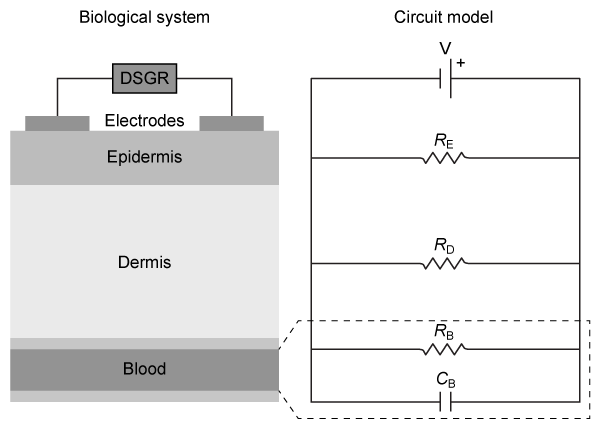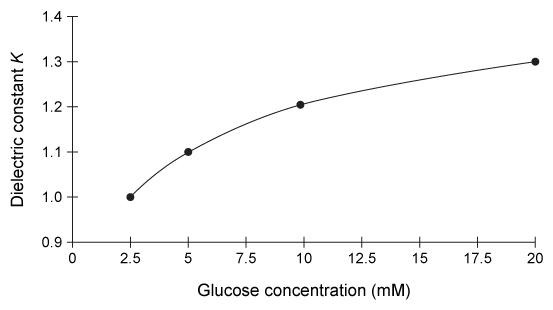Passage
The electric capacitance of biological tissues serves as the basis for numerous medical technologies. For example, dielectric spectroscopy glucose reading (DSGR) is a noninvasive diagnostic technique that uses the electric capacitance of blood to estimate blood glucose levels.A DSGR device records the electric current that results from applying a voltage source to the skin and underlying blood vessels. DSGR can be modeled by the circuit shown in Figure 1, in which V represents the applied potential, CB represents the capacitance of the blood, and RE, RD, and RB represent the electrical resistances of the epidermis, the dermis, and the blood, respectively.
 Figure 1 DSGR circuit model including skin and superficial blood vesselThe capacitance of charged blood may be explained by red blood cell membranes acting as physical barriers that separate electrons introduced into the blood from positively charged ions in the red blood cell cytoplasm. The dielectric constant k of red blood cell membranes varies with glucose concentration (Figure 2) because glucose uptake by red blood cells alters the activity of membrane-bound proteins that regulate the flow of ions into and out of the cell.
Figure 1 DSGR circuit model including skin and superficial blood vesselThe capacitance of charged blood may be explained by red blood cell membranes acting as physical barriers that separate electrons introduced into the blood from positively charged ions in the red blood cell cytoplasm. The dielectric constant k of red blood cell membranes varies with glucose concentration (Figure 2) because glucose uptake by red blood cells alters the activity of membrane-bound proteins that regulate the flow of ions into and out of the cell.
 Figure 2 Blood dielectric constant vs blood glucose concentrationDSGR readings vary with blood glucose concentration because the time needed to fully charge the blood is related to total blood capacitance. However, interpreting DSGR readings may be complicated by changes in biological variables other than blood capacitance. For example, the resistivity of blood varies in accordance with osmolarity such that changes in diet or hydration status influence the current measured by DSGR devices.
Figure 2 Blood dielectric constant vs blood glucose concentrationDSGR readings vary with blood glucose concentration because the time needed to fully charge the blood is related to total blood capacitance. However, interpreting DSGR readings may be complicated by changes in biological variables other than blood capacitance. For example, the resistivity of blood varies in accordance with osmolarity such that changes in diet or hydration status influence the current measured by DSGR devices.
Livshits, L. et al. Dielectric response of biconcave erythrocyte membranes to D- and L-glucose. J. Phys. D: Appl. Phys. 40 (2007) , 15-19.
-To simplify calculations, mathematical models of DSGR can be generated that replace RE and RD in Figure 1 with an equivalent resistor Req. The mathematical expression for Req is:
A) RE + RD
B) RE ∙ RD
C) (RE + RD) /(RE ∙ RD)
D) (RE ∙ RD) /(RE + RD)
Correct Answer:
Verified
Q25: Passage
The humerus bone in the upper arm
Q26: Passage
For a person with perfect vision, light
Q27: Passage
A traumatic brain injury (TBI) is a
Q28: Passage
A traumatic brain injury (TBI) is a
Q29: Passage
A traumatic brain injury (TBI) is a
Q31: Passage
For a person with perfect vision, light
Q32: Passage
For a person with perfect vision, light
Q33: Passage
A traumatic brain injury (TBI) is a
Q34: Passage
The electric capacitance of biological tissues serves
Q35: Passage
The electric capacitance of biological tissues serves
Unlock this Answer For Free Now!
View this answer and more for free by performing one of the following actions

Scan the QR code to install the App and get 2 free unlocks

Unlock quizzes for free by uploading documents